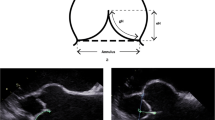Summary
In order to investigate the clinicopathological characteristics of aortic valve disease in children, all the native surgically excised aortic valves obtained between January 2003 and December 2005 were studied macroscopically and microscopically. The patients’ medical records were reviewed and the clinical information was extracted. According to preoperative echocardiography, intraoperative assessment, and postoperative pathology, combined with clinical symptoms and signs, aortic valve diseases were divided into three categories: aortic stenosis (AS), aortic insufficiency (AI), and aortic stenosis with insufficiency (AS-AI). The etiology was determined according to the macroscopic, microscopic and clinical findings. The results showed that among 70 aortic valves, patient age ranged from 6 to 18 years, with a mean of 15.4 years, and there were 56 boys and 14 girls (male: female=4:1). Forty-four children only had pure aortic valve disease, and the other 26 children had aortic valve disease associated with other heart valve diseases. There were 5 cases of AS (7.14%), 60 cases of AI (85.71%) and 5 cases of AS-AI (7.14%). The causes were congenital aortic valve malformation (32 cases, 45.71%), rheumatic disease (28 cases, 40%), infective endocarditis (7 cases, 10%), Marfan syndrome (2 cases, 2.86%), and undetermined (1 case, 1.43%). It was concluded that the common causes of aortic valve disease in order of frequency in children were congenital aortic valve malformation, rheumatic disease, infective endocarditis, and Marfan syndrome. AI was more common in children with aortic valve disease. Compared with adult patients, congenital bicuspid aortic valve in children was often AI. Histologically, the leaflets of congenital bicuspid aortic valve were mainly myxomatous, fibrosis and calcification less seen. AI was frequently found in rheumatic disease, mostly associated with other heart valve diseases. Macroscopic and microscopic examinations together with clinical information, echocardiographic findings and operative details were important in evaluating the etiology of aortic valve disease.
Similar content being viewed by others
References
Fondard O, Detaint D, Lung B et al. Extracellular matrix remodeling in human aortic valve disease: the role of matrix metalloproteinases and their tissue inhibitors. Eur Heart J, 2005,26:1333–1341
Schoen F J. Cardiac valves and valvular pathology: update on function, disease, repair, and replacement. Cardiovasc Pathol, 2005,14:189–194
Tayloy P M, Allen S P, Yacoub M H. Phenotypic and functional characterization of interstitial cells from human heart valves, pericardium and skin. J Heart Valve Dis, 2000,9:150–158
Agozzino L, Falco A, De Luca Tupputi Schinosa L et al. Surgical pathology of the aortic valve: a morphologic study on 912 surgically excised valves. G Ital Cardiol, 1992,22:1169–1177
Chuangsuwanich T, Warnnissorn M, Leksrisakul P et al. Pathology and etiology of 110 consecutively removed aortic valves. J Med Assoc Thai, 2004,87:921–934
Butany J, Collins M J, Demellawy D E et al. Morphological and clinical findings in 247 surgically excised native aortic valves. Can J Cardiol, 2005,21:747–755
Bartram U, Bartelings M M, Kramer H H et al. Congenital polyvalvular disease: a review. Pediatr Cardiol, 2001,22:93–101
Roberts W C, Ko J M. Frequency by decades of unicuspid, bicuspid, and tricuspid aortic valves in adults having isolated aortic valve replacement for aortic stenosis, with or without associated aortic regurgitation. Circulation, 2005,111:920–925
Lewin M B, Otto C M. The bicuspid aortic valve: adverse outcomes from infancy to old age. Circulation, 2005,111:832–834
Segura A M, Luna R E, Horiba K et al. Immunohistochemistry of matrix metalloproteinases and their inhibitors in thoracic aortic aneurysms and aortic valves of patients with Marfan’s syndrome. Circulation, 1998, 98: II 331–II 338
Author information
Authors and Affiliations
Additional information
HUANG Ping, male, born in 1963, M. D., Ph. D.
Rights and permissions
About this article
Cite this article
Huang, P., Wang, H., Zhang, Z. et al. A clinicopathological study on aortic valves in children. J. Huazhong Univ. Sc. Technol. 27, 321–325 (2007). https://doi.org/10.1007/s11596-007-0327-3
Received:
Issue Date:
DOI: https://doi.org/10.1007/s11596-007-0327-3




